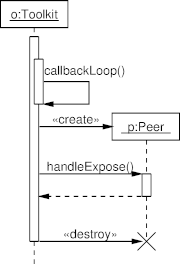Automated Drawing of UML Diagrams
UMLGraph allows the declarative specification and drawing ofUML class and sequence diagrams.The current featuresare part of an ongoing effort aiming to provide support forall types UML diagrams.An
IEEE Software article titled On the declarative specification of modelsexplains the rationale behind this approach.The tehnology behind UMLGraph was used to draw many of the diagramsappearing in the award-winning books Code Quality: The Open Source Perspective (Addison Wesley, 2006) and Code Reading: The Open Source Perspective (Addison Wesley, 2003).In addition,the
UMLGraphDoc doclet included in this distribution automaticallyadds UML diagrams to javadoc documentation.
Many programs build on UMLGraph; follow this linkfor more details.In addition,Martin Fowler, the author ofUML Distilled, writes:
I thought I'd send you a note saying how much I enjoyed discovering UML Graph.I've long fancied a text based way of describing UML diagrams,but never felt sufficiently time-rich to develop anything.
Class Diagrams
One specifies a class diagram using the Java syntax complemented by javadoctags.Running the UmlGraph doclet on the specification will generatea Graphvizdiagram specification that can be automatically processed tocreate Postscript, GIF, SVG, JPEG, fig, or Framemaker drawings.The following is an example of a class diagram specification and the resulting UMLdiagram:
class Person {
String Name;
}
class Employee extends Person {}
class Client extends Person {}
|
 |
Sequence Diagrams
One specifies a sequence diagram using pic macros to defineobjects and method invocations.The GNU plotutils pic2plot program can then process the sequence diagram to create aPNG, PNM, (pseudo)GIF, SVG, AI, Postscript, CGM, FIG, PCL, HPGL, Regis, or TEKdrawing.The following is an example of a sequence diagram specification and theresulting UML diagram:
